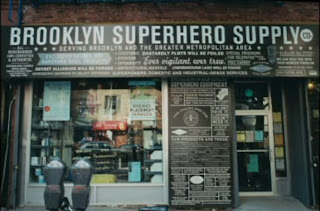This is Carson Everett, posing outside 826 Valencia, Pirate gear shop and learning center for kids aged 7 -18.
Carson is the longest running attending student and is actually older than what's allowed at the age of 21, but he brings his unique personality to the space and is hoping to become a history teacher one day.

I tried to continue on my path of filming my research work for my dissertation but was denied to use of any video or photographic equipment inside the learning center.
I emailed the people at 826 Valencia in San Francisco in advance to ask them if it was OK for me to pop around for a chat and a first hand experience of the place which I have researched earlier in research work. You can read more about the background of this project further down on this page.
I spoke to Jory John, Program Director at 826 Valencia. He briefed me about some facts and I responded with questions connecting to my dissertation.
Some facts in brief about the learning center/pirate shop.
1400 volunteers
6000 students since 2002
Financed by grants, donations and some through profit of the pirate shop
Most students attend on an annual basis after school to get helped with their homework
I asked the following questions to Jory:
Why is has this project turn out to be a success?
There was a need for extra help and attention and the kids are not distracted, and the fact that their work is real, tangible and can/will be published. It has involved the community and engages people that come into the store to just look at the pirate equipment. These customers always wonder what's in the big space in the back and it's a good talking point to get new volunteers to join as a tutor. One other main key is flexibility. Even if you only can work 2 hours per month, they will accept that and that's why they have got so many volunteers from many different special fields.
Are they encouraged to be creative?
Yes, through writing and especially on field-trips.
(I attended a field-trip the next morning and experienced how it was. There was a group of kids facing a stage with a leader, teacher or whatever you'd like to call it conducting a writing session of a story which was created together as a part of a team. There was also an 'enemy' , a pirate on the second floor which no-one could see that shouted to the kids that they couldn't do it, creating an antagonist that made the kids work harder together.)
Even though it is very similar to school, what is it that makes it so much more motivating?
The design is very unlike a school and it has got a really nice feeling to it. The kids don't think school when entering and that is a key to success even though they might be doing the sam type of work. The kids also feel a sense of ownership of the place which makes them more motivated and careful with the environment.
I took part as a tutor and helped a kid named Anthony Royes with his homework. I also had the time to ask a few questions, I was unfortunately not allowed to photograph him.
Anthony feels that he can focus better at the learning center and it's because he knows that he can meet friends here and there's a routine for him to get the homework done and after he can go on-line to play games as he hasn't got internet at home. The environment is different to school.
My personal experience however was that it was difficult to interfere if one kid was disruptive, affecting other kids negatively. The guy next to the kid I was helping out wasn't focusing at all and it was hard to get through to him. I was hoping that this learning resource center would not have to act like a school but only focus on the fun and creative. But I soon realized that so wasn't the case. I asked Jory what they usually do to kids that are disruptive as the 'classes' are voluntarily and for free. Unfortunately there seemed to be as much administration and politics as with a school. They had meetings with kids' parents and condced warnings if the kid wouldn't conform. I guess that is the reality of things.
Overall the concept is interesting, engaging due to its location and store plus that it has got a wide range of ages on the kids working next to one another, not competing or comparing as much as in class with equally aged peers.






